Legal Responsibilities of Directors and Partners in Company Law
VerifiedAdded on 2022/09/09
|13
|2897
|9
Report
AI Summary
This report delves into the legal responsibilities of directors and partners within the framework of company law. It begins by outlining the duties of directors, including the obligation to act in good faith, exercise due diligence, and properly utilize company resources, as per the Corporations Act 2001. The report also addresses the fiduciary responsibilities of partners in a partnership. The core of the report analyzes a scenario involving directors and partners, highlighting potential violations of these responsibilities, such as breaches of sections 180, 181, 182, 183, and 588G of the Corporations Act. The analysis incorporates relevant case law to support the arguments. Finally, the report concludes with a discussion of the legal consequences that may arise from these violations, providing a comprehensive overview of the legal implications for the parties involved. The report examines the responsibilities and violations related to directors and partners in a company law context, providing a comprehensive analysis of the legal implications and relevant case laws.
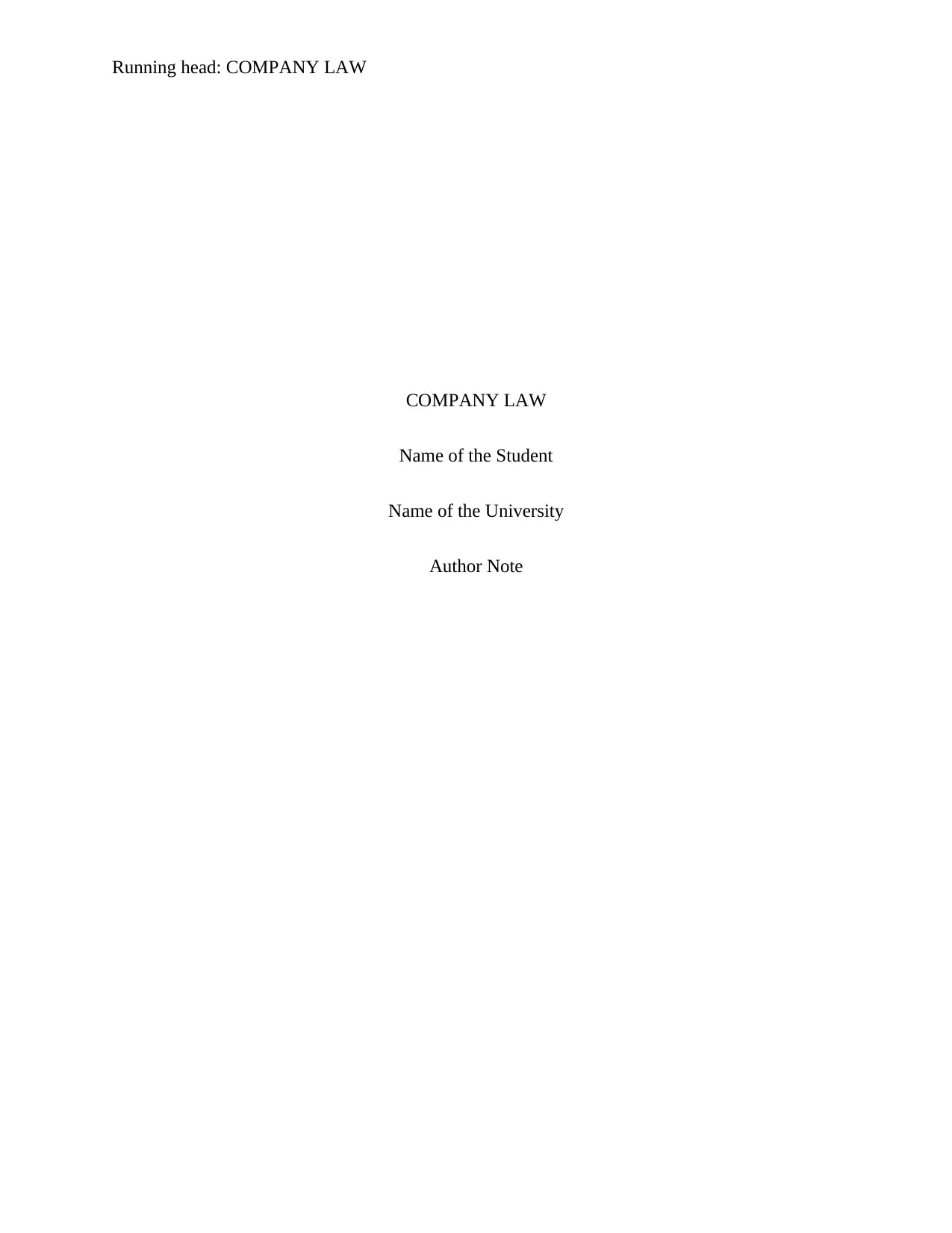
Running head: COMPANY LAW
COMPANY LAW
Name of the Student
Name of the University
Author Note
COMPANY LAW
Name of the Student
Name of the University
Author Note
Paraphrase This Document
Need a fresh take? Get an instant paraphrase of this document with our AI Paraphraser
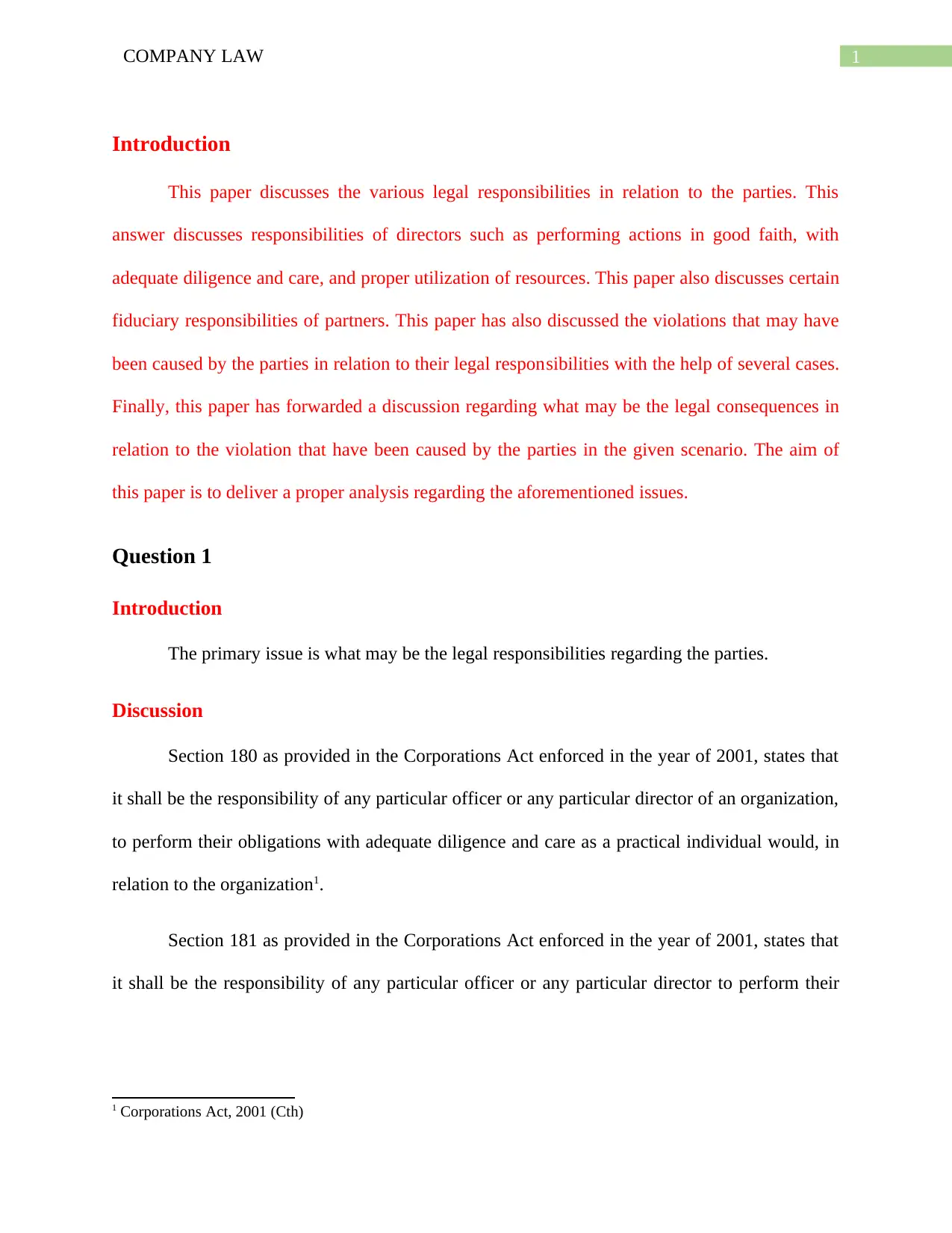
1COMPANY LAW
Introduction
This paper discusses the various legal responsibilities in relation to the parties. This
answer discusses responsibilities of directors such as performing actions in good faith, with
adequate diligence and care, and proper utilization of resources. This paper also discusses certain
fiduciary responsibilities of partners. This paper has also discussed the violations that may have
been caused by the parties in relation to their legal responsibilities with the help of several cases.
Finally, this paper has forwarded a discussion regarding what may be the legal consequences in
relation to the violation that have been caused by the parties in the given scenario. The aim of
this paper is to deliver a proper analysis regarding the aforementioned issues.
Question 1
Introduction
The primary issue is what may be the legal responsibilities regarding the parties.
Discussion
Section 180 as provided in the Corporations Act enforced in the year of 2001, states that
it shall be the responsibility of any particular officer or any particular director of an organization,
to perform their obligations with adequate diligence and care as a practical individual would, in
relation to the organization1.
Section 181 as provided in the Corporations Act enforced in the year of 2001, states that
it shall be the responsibility of any particular officer or any particular director to perform their
1 Corporations Act, 2001 (Cth)
Introduction
This paper discusses the various legal responsibilities in relation to the parties. This
answer discusses responsibilities of directors such as performing actions in good faith, with
adequate diligence and care, and proper utilization of resources. This paper also discusses certain
fiduciary responsibilities of partners. This paper has also discussed the violations that may have
been caused by the parties in relation to their legal responsibilities with the help of several cases.
Finally, this paper has forwarded a discussion regarding what may be the legal consequences in
relation to the violation that have been caused by the parties in the given scenario. The aim of
this paper is to deliver a proper analysis regarding the aforementioned issues.
Question 1
Introduction
The primary issue is what may be the legal responsibilities regarding the parties.
Discussion
Section 180 as provided in the Corporations Act enforced in the year of 2001, states that
it shall be the responsibility of any particular officer or any particular director of an organization,
to perform their obligations with adequate diligence and care as a practical individual would, in
relation to the organization1.
Section 181 as provided in the Corporations Act enforced in the year of 2001, states that
it shall be the responsibility of any particular officer or any particular director to perform their
1 Corporations Act, 2001 (Cth)
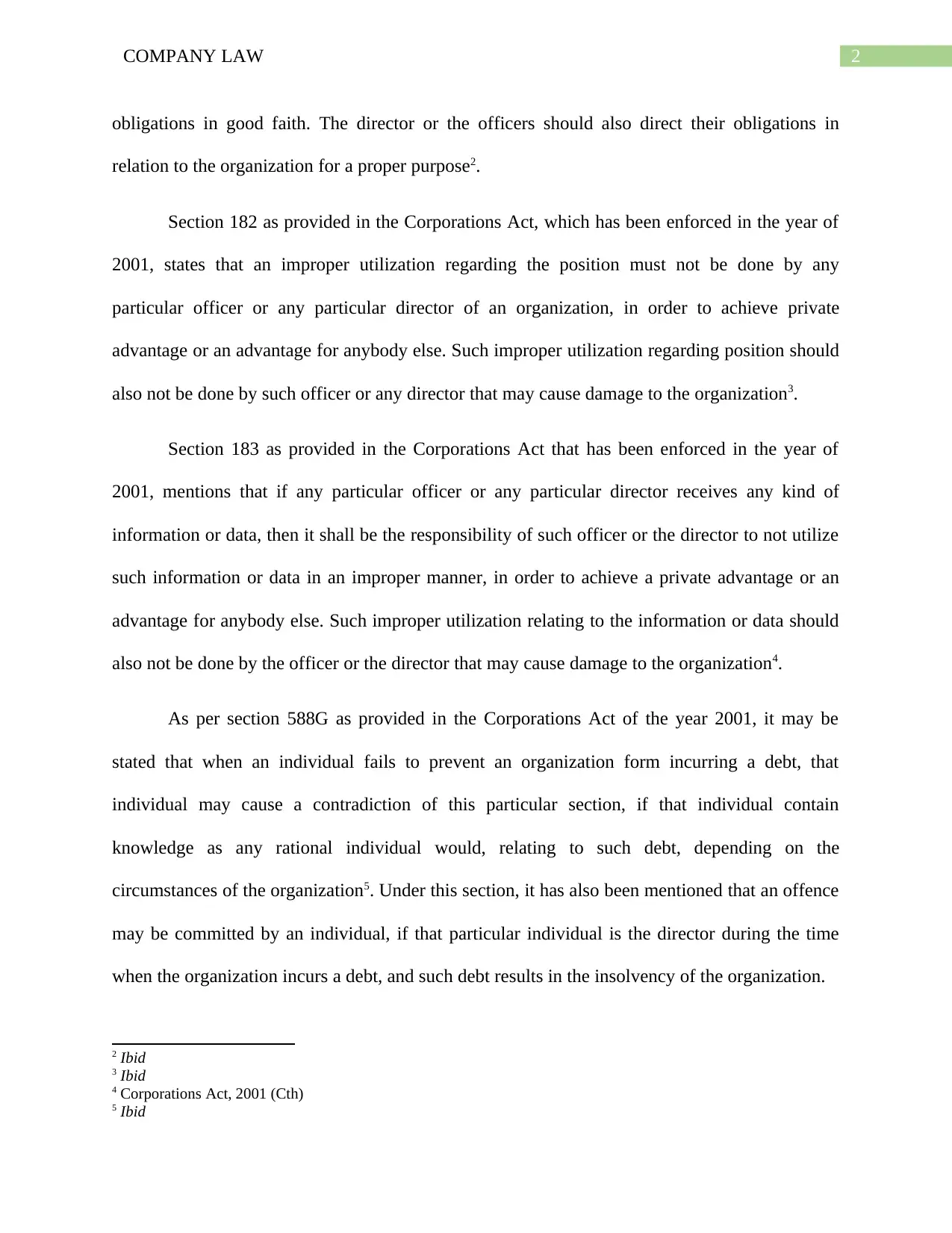
2COMPANY LAW
obligations in good faith. The director or the officers should also direct their obligations in
relation to the organization for a proper purpose2.
Section 182 as provided in the Corporations Act, which has been enforced in the year of
2001, states that an improper utilization regarding the position must not be done by any
particular officer or any particular director of an organization, in order to achieve private
advantage or an advantage for anybody else. Such improper utilization regarding position should
also not be done by such officer or any director that may cause damage to the organization3.
Section 183 as provided in the Corporations Act that has been enforced in the year of
2001, mentions that if any particular officer or any particular director receives any kind of
information or data, then it shall be the responsibility of such officer or the director to not utilize
such information or data in an improper manner, in order to achieve a private advantage or an
advantage for anybody else. Such improper utilization relating to the information or data should
also not be done by the officer or the director that may cause damage to the organization4.
As per section 588G as provided in the Corporations Act of the year 2001, it may be
stated that when an individual fails to prevent an organization form incurring a debt, that
individual may cause a contradiction of this particular section, if that individual contain
knowledge as any rational individual would, relating to such debt, depending on the
circumstances of the organization5. Under this section, it has also been mentioned that an offence
may be committed by an individual, if that particular individual is the director during the time
when the organization incurs a debt, and such debt results in the insolvency of the organization.
2 Ibid
3 Ibid
4 Corporations Act, 2001 (Cth)
5 Ibid
obligations in good faith. The director or the officers should also direct their obligations in
relation to the organization for a proper purpose2.
Section 182 as provided in the Corporations Act, which has been enforced in the year of
2001, states that an improper utilization regarding the position must not be done by any
particular officer or any particular director of an organization, in order to achieve private
advantage or an advantage for anybody else. Such improper utilization regarding position should
also not be done by such officer or any director that may cause damage to the organization3.
Section 183 as provided in the Corporations Act that has been enforced in the year of
2001, mentions that if any particular officer or any particular director receives any kind of
information or data, then it shall be the responsibility of such officer or the director to not utilize
such information or data in an improper manner, in order to achieve a private advantage or an
advantage for anybody else. Such improper utilization relating to the information or data should
also not be done by the officer or the director that may cause damage to the organization4.
As per section 588G as provided in the Corporations Act of the year 2001, it may be
stated that when an individual fails to prevent an organization form incurring a debt, that
individual may cause a contradiction of this particular section, if that individual contain
knowledge as any rational individual would, relating to such debt, depending on the
circumstances of the organization5. Under this section, it has also been mentioned that an offence
may be committed by an individual, if that particular individual is the director during the time
when the organization incurs a debt, and such debt results in the insolvency of the organization.
2 Ibid
3 Ibid
4 Corporations Act, 2001 (Cth)
5 Ibid
⊘ This is a preview!⊘
Do you want full access?
Subscribe today to unlock all pages.

Trusted by 1+ million students worldwide
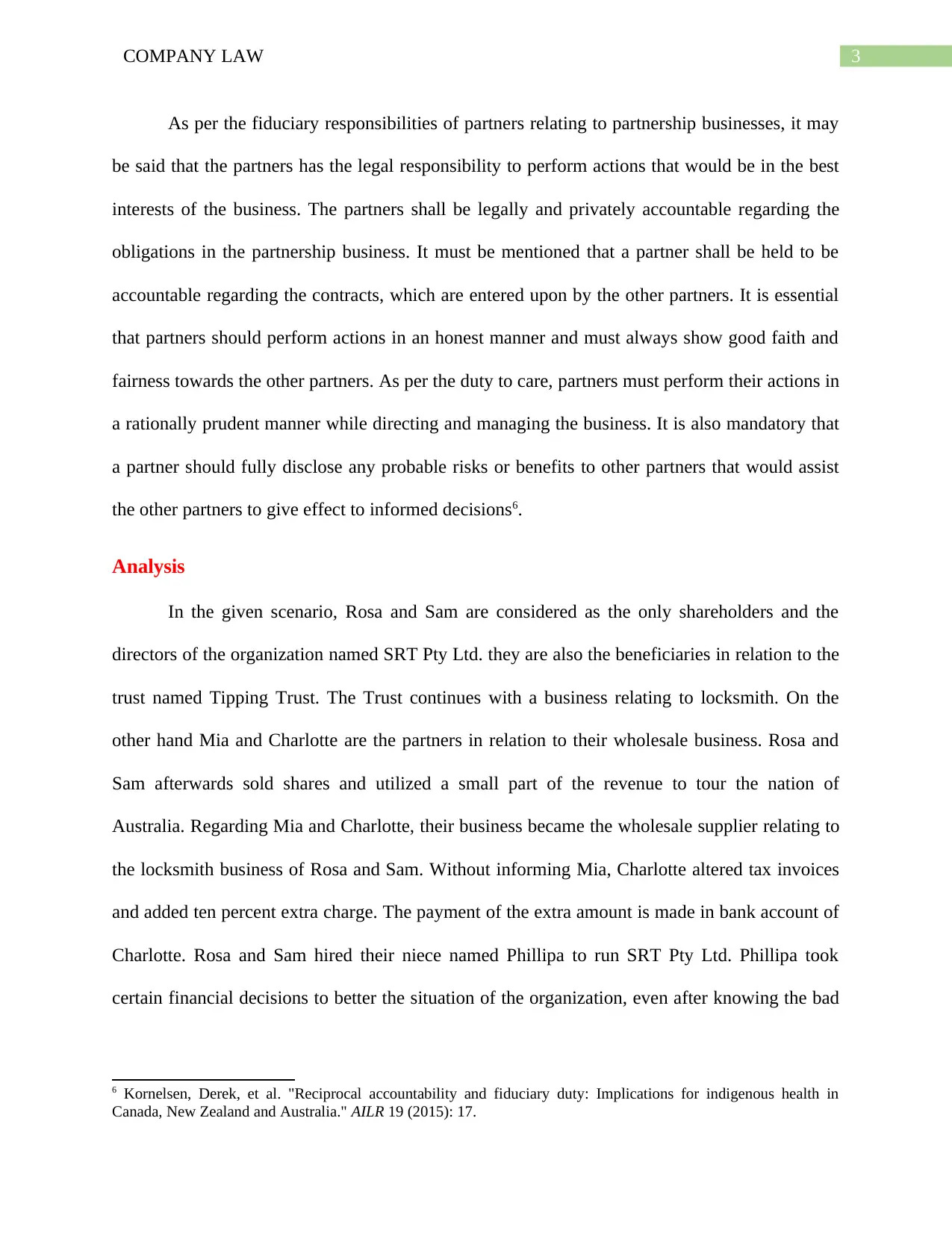
3COMPANY LAW
As per the fiduciary responsibilities of partners relating to partnership businesses, it may
be said that the partners has the legal responsibility to perform actions that would be in the best
interests of the business. The partners shall be legally and privately accountable regarding the
obligations in the partnership business. It must be mentioned that a partner shall be held to be
accountable regarding the contracts, which are entered upon by the other partners. It is essential
that partners should perform actions in an honest manner and must always show good faith and
fairness towards the other partners. As per the duty to care, partners must perform their actions in
a rationally prudent manner while directing and managing the business. It is also mandatory that
a partner should fully disclose any probable risks or benefits to other partners that would assist
the other partners to give effect to informed decisions6.
Analysis
In the given scenario, Rosa and Sam are considered as the only shareholders and the
directors of the organization named SRT Pty Ltd. they are also the beneficiaries in relation to the
trust named Tipping Trust. The Trust continues with a business relating to locksmith. On the
other hand Mia and Charlotte are the partners in relation to their wholesale business. Rosa and
Sam afterwards sold shares and utilized a small part of the revenue to tour the nation of
Australia. Regarding Mia and Charlotte, their business became the wholesale supplier relating to
the locksmith business of Rosa and Sam. Without informing Mia, Charlotte altered tax invoices
and added ten percent extra charge. The payment of the extra amount is made in bank account of
Charlotte. Rosa and Sam hired their niece named Phillipa to run SRT Pty Ltd. Phillipa took
certain financial decisions to better the situation of the organization, even after knowing the bad
6 Kornelsen, Derek, et al. "Reciprocal accountability and fiduciary duty: Implications for indigenous health in
Canada, New Zealand and Australia." AILR 19 (2015): 17.
As per the fiduciary responsibilities of partners relating to partnership businesses, it may
be said that the partners has the legal responsibility to perform actions that would be in the best
interests of the business. The partners shall be legally and privately accountable regarding the
obligations in the partnership business. It must be mentioned that a partner shall be held to be
accountable regarding the contracts, which are entered upon by the other partners. It is essential
that partners should perform actions in an honest manner and must always show good faith and
fairness towards the other partners. As per the duty to care, partners must perform their actions in
a rationally prudent manner while directing and managing the business. It is also mandatory that
a partner should fully disclose any probable risks or benefits to other partners that would assist
the other partners to give effect to informed decisions6.
Analysis
In the given scenario, Rosa and Sam are considered as the only shareholders and the
directors of the organization named SRT Pty Ltd. they are also the beneficiaries in relation to the
trust named Tipping Trust. The Trust continues with a business relating to locksmith. On the
other hand Mia and Charlotte are the partners in relation to their wholesale business. Rosa and
Sam afterwards sold shares and utilized a small part of the revenue to tour the nation of
Australia. Regarding Mia and Charlotte, their business became the wholesale supplier relating to
the locksmith business of Rosa and Sam. Without informing Mia, Charlotte altered tax invoices
and added ten percent extra charge. The payment of the extra amount is made in bank account of
Charlotte. Rosa and Sam hired their niece named Phillipa to run SRT Pty Ltd. Phillipa took
certain financial decisions to better the situation of the organization, even after knowing the bad
6 Kornelsen, Derek, et al. "Reciprocal accountability and fiduciary duty: Implications for indigenous health in
Canada, New Zealand and Australia." AILR 19 (2015): 17.
Paraphrase This Document
Need a fresh take? Get an instant paraphrase of this document with our AI Paraphraser
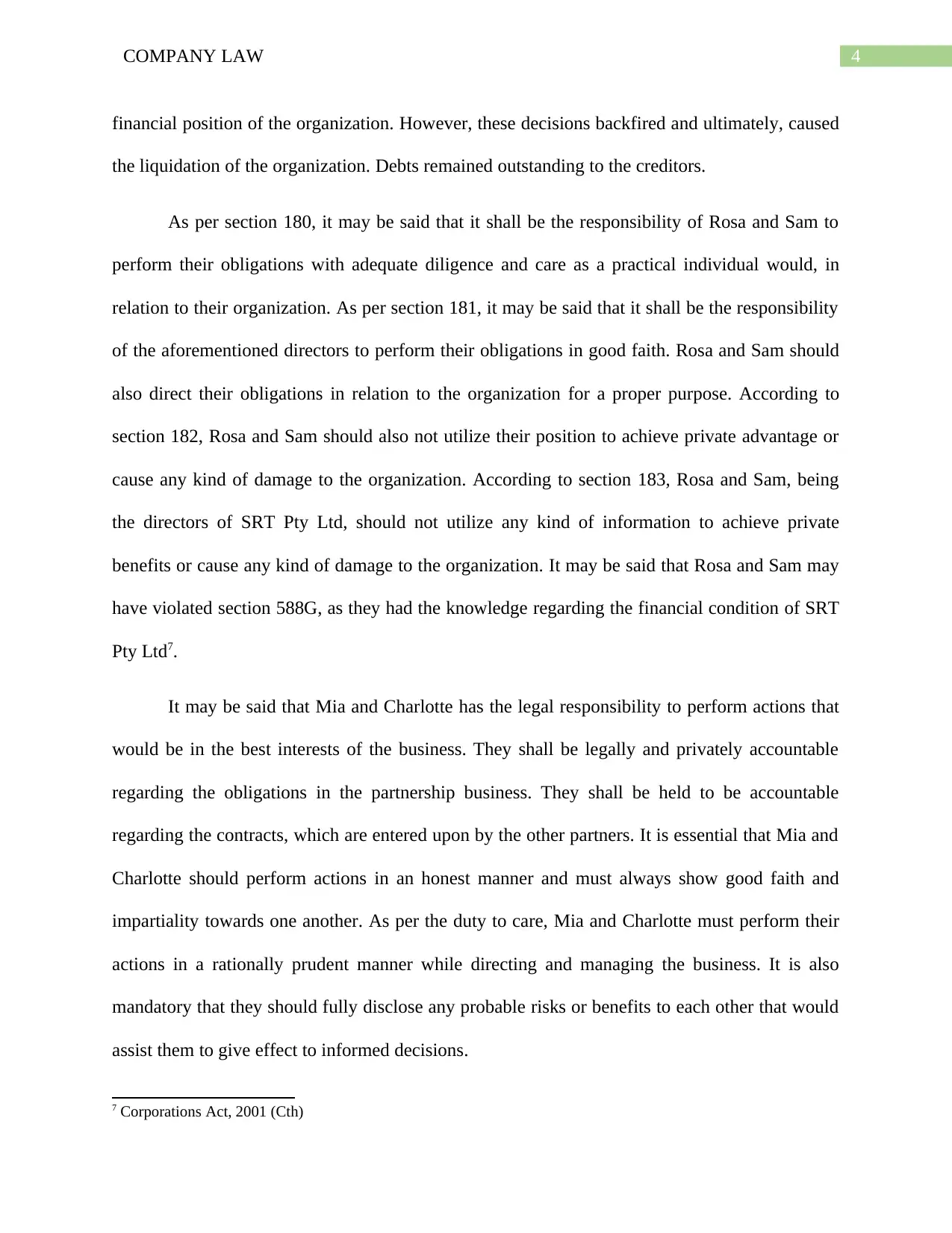
4COMPANY LAW
financial position of the organization. However, these decisions backfired and ultimately, caused
the liquidation of the organization. Debts remained outstanding to the creditors.
As per section 180, it may be said that it shall be the responsibility of Rosa and Sam to
perform their obligations with adequate diligence and care as a practical individual would, in
relation to their organization. As per section 181, it may be said that it shall be the responsibility
of the aforementioned directors to perform their obligations in good faith. Rosa and Sam should
also direct their obligations in relation to the organization for a proper purpose. According to
section 182, Rosa and Sam should also not utilize their position to achieve private advantage or
cause any kind of damage to the organization. According to section 183, Rosa and Sam, being
the directors of SRT Pty Ltd, should not utilize any kind of information to achieve private
benefits or cause any kind of damage to the organization. It may be said that Rosa and Sam may
have violated section 588G, as they had the knowledge regarding the financial condition of SRT
Pty Ltd7.
It may be said that Mia and Charlotte has the legal responsibility to perform actions that
would be in the best interests of the business. They shall be legally and privately accountable
regarding the obligations in the partnership business. They shall be held to be accountable
regarding the contracts, which are entered upon by the other partners. It is essential that Mia and
Charlotte should perform actions in an honest manner and must always show good faith and
impartiality towards one another. As per the duty to care, Mia and Charlotte must perform their
actions in a rationally prudent manner while directing and managing the business. It is also
mandatory that they should fully disclose any probable risks or benefits to each other that would
assist them to give effect to informed decisions.
7 Corporations Act, 2001 (Cth)
financial position of the organization. However, these decisions backfired and ultimately, caused
the liquidation of the organization. Debts remained outstanding to the creditors.
As per section 180, it may be said that it shall be the responsibility of Rosa and Sam to
perform their obligations with adequate diligence and care as a practical individual would, in
relation to their organization. As per section 181, it may be said that it shall be the responsibility
of the aforementioned directors to perform their obligations in good faith. Rosa and Sam should
also direct their obligations in relation to the organization for a proper purpose. According to
section 182, Rosa and Sam should also not utilize their position to achieve private advantage or
cause any kind of damage to the organization. According to section 183, Rosa and Sam, being
the directors of SRT Pty Ltd, should not utilize any kind of information to achieve private
benefits or cause any kind of damage to the organization. It may be said that Rosa and Sam may
have violated section 588G, as they had the knowledge regarding the financial condition of SRT
Pty Ltd7.
It may be said that Mia and Charlotte has the legal responsibility to perform actions that
would be in the best interests of the business. They shall be legally and privately accountable
regarding the obligations in the partnership business. They shall be held to be accountable
regarding the contracts, which are entered upon by the other partners. It is essential that Mia and
Charlotte should perform actions in an honest manner and must always show good faith and
impartiality towards one another. As per the duty to care, Mia and Charlotte must perform their
actions in a rationally prudent manner while directing and managing the business. It is also
mandatory that they should fully disclose any probable risks or benefits to each other that would
assist them to give effect to informed decisions.
7 Corporations Act, 2001 (Cth)
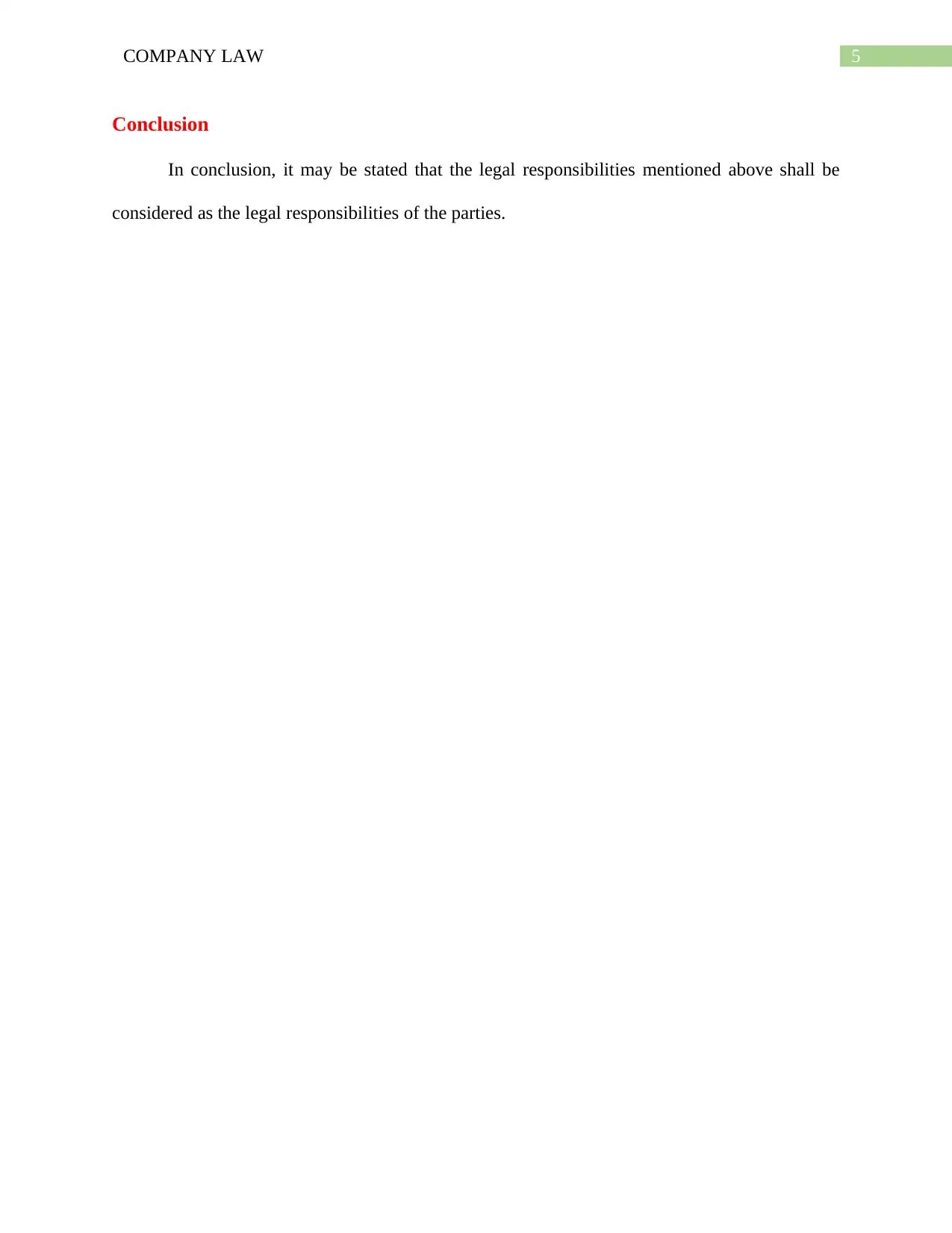
5COMPANY LAW
Conclusion
In conclusion, it may be stated that the legal responsibilities mentioned above shall be
considered as the legal responsibilities of the parties.
Conclusion
In conclusion, it may be stated that the legal responsibilities mentioned above shall be
considered as the legal responsibilities of the parties.
⊘ This is a preview!⊘
Do you want full access?
Subscribe today to unlock all pages.

Trusted by 1+ million students worldwide
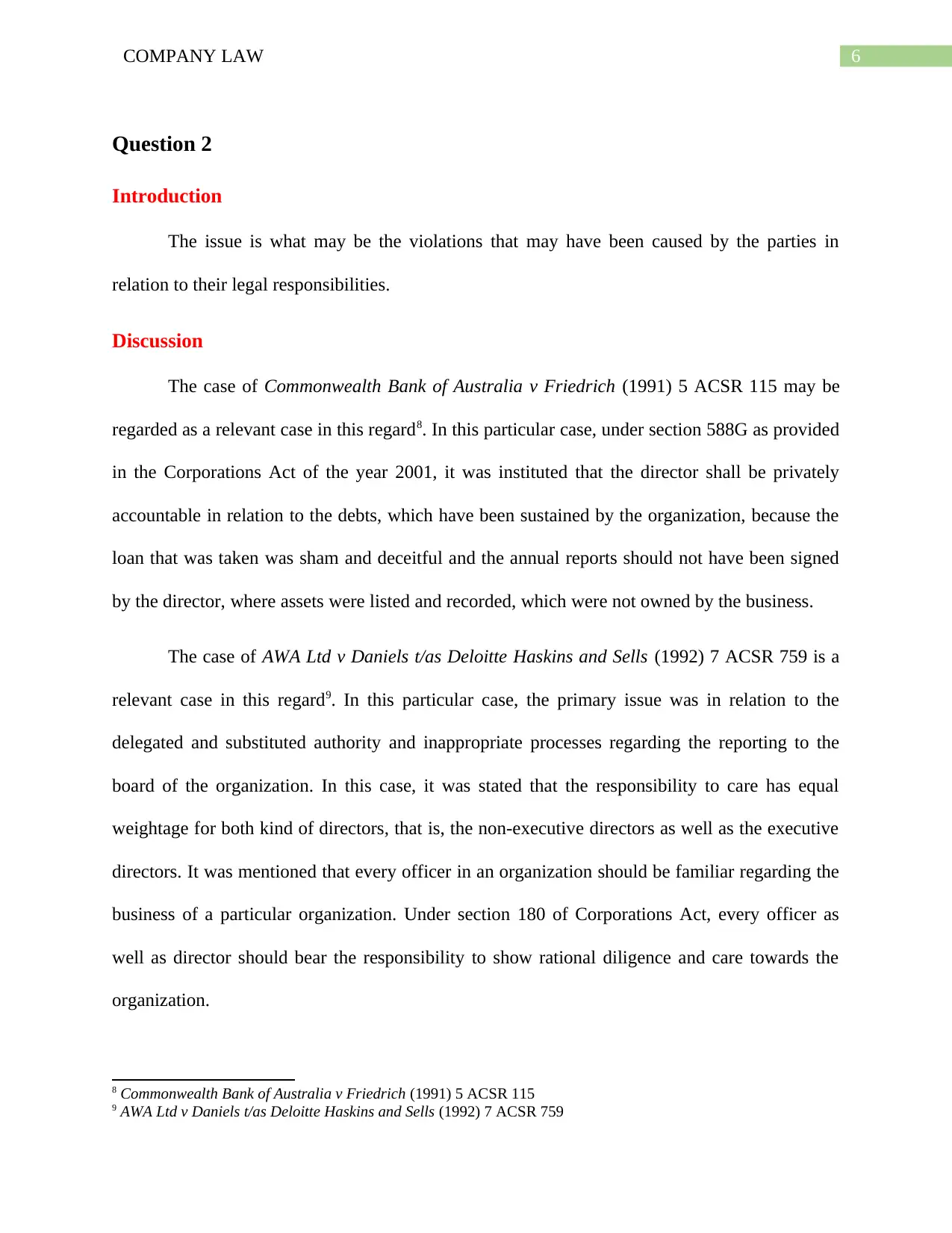
6COMPANY LAW
Question 2
Introduction
The issue is what may be the violations that may have been caused by the parties in
relation to their legal responsibilities.
Discussion
The case of Commonwealth Bank of Australia v Friedrich (1991) 5 ACSR 115 may be
regarded as a relevant case in this regard8. In this particular case, under section 588G as provided
in the Corporations Act of the year 2001, it was instituted that the director shall be privately
accountable in relation to the debts, which have been sustained by the organization, because the
loan that was taken was sham and deceitful and the annual reports should not have been signed
by the director, where assets were listed and recorded, which were not owned by the business.
The case of AWA Ltd v Daniels t/as Deloitte Haskins and Sells (1992) 7 ACSR 759 is a
relevant case in this regard9. In this particular case, the primary issue was in relation to the
delegated and substituted authority and inappropriate processes regarding the reporting to the
board of the organization. In this case, it was stated that the responsibility to care has equal
weightage for both kind of directors, that is, the non-executive directors as well as the executive
directors. It was mentioned that every officer in an organization should be familiar regarding the
business of a particular organization. Under section 180 of Corporations Act, every officer as
well as director should bear the responsibility to show rational diligence and care towards the
organization.
8 Commonwealth Bank of Australia v Friedrich (1991) 5 ACSR 115
9 AWA Ltd v Daniels t/as Deloitte Haskins and Sells (1992) 7 ACSR 759
Question 2
Introduction
The issue is what may be the violations that may have been caused by the parties in
relation to their legal responsibilities.
Discussion
The case of Commonwealth Bank of Australia v Friedrich (1991) 5 ACSR 115 may be
regarded as a relevant case in this regard8. In this particular case, under section 588G as provided
in the Corporations Act of the year 2001, it was instituted that the director shall be privately
accountable in relation to the debts, which have been sustained by the organization, because the
loan that was taken was sham and deceitful and the annual reports should not have been signed
by the director, where assets were listed and recorded, which were not owned by the business.
The case of AWA Ltd v Daniels t/as Deloitte Haskins and Sells (1992) 7 ACSR 759 is a
relevant case in this regard9. In this particular case, the primary issue was in relation to the
delegated and substituted authority and inappropriate processes regarding the reporting to the
board of the organization. In this case, it was stated that the responsibility to care has equal
weightage for both kind of directors, that is, the non-executive directors as well as the executive
directors. It was mentioned that every officer in an organization should be familiar regarding the
business of a particular organization. Under section 180 of Corporations Act, every officer as
well as director should bear the responsibility to show rational diligence and care towards the
organization.
8 Commonwealth Bank of Australia v Friedrich (1991) 5 ACSR 115
9 AWA Ltd v Daniels t/as Deloitte Haskins and Sells (1992) 7 ACSR 759
Paraphrase This Document
Need a fresh take? Get an instant paraphrase of this document with our AI Paraphraser
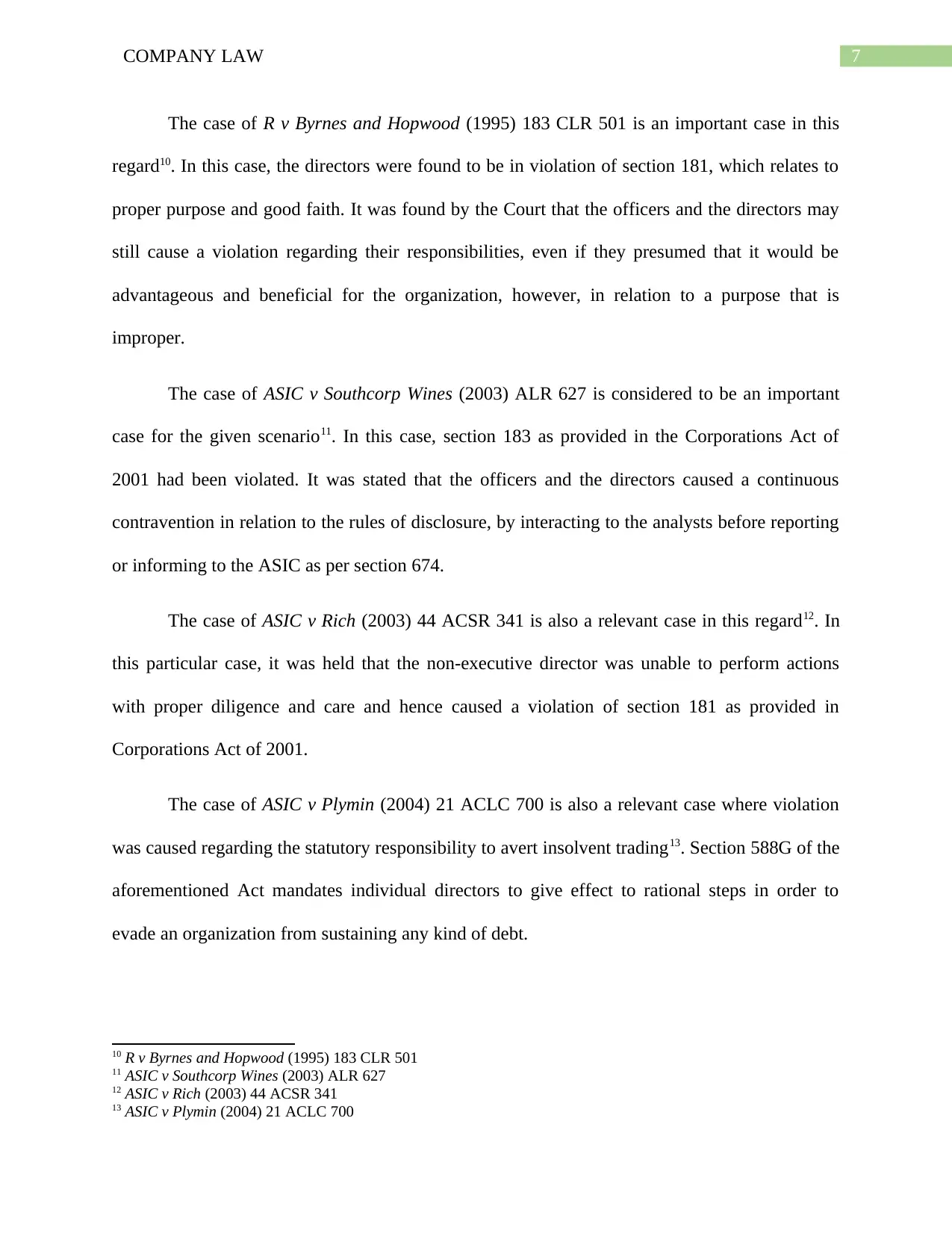
7COMPANY LAW
The case of R v Byrnes and Hopwood (1995) 183 CLR 501 is an important case in this
regard10. In this case, the directors were found to be in violation of section 181, which relates to
proper purpose and good faith. It was found by the Court that the officers and the directors may
still cause a violation regarding their responsibilities, even if they presumed that it would be
advantageous and beneficial for the organization, however, in relation to a purpose that is
improper.
The case of ASIC v Southcorp Wines (2003) ALR 627 is considered to be an important
case for the given scenario11. In this case, section 183 as provided in the Corporations Act of
2001 had been violated. It was stated that the officers and the directors caused a continuous
contravention in relation to the rules of disclosure, by interacting to the analysts before reporting
or informing to the ASIC as per section 674.
The case of ASIC v Rich (2003) 44 ACSR 341 is also a relevant case in this regard12. In
this particular case, it was held that the non-executive director was unable to perform actions
with proper diligence and care and hence caused a violation of section 181 as provided in
Corporations Act of 2001.
The case of ASIC v Plymin (2004) 21 ACLC 700 is also a relevant case where violation
was caused regarding the statutory responsibility to avert insolvent trading13. Section 588G of the
aforementioned Act mandates individual directors to give effect to rational steps in order to
evade an organization from sustaining any kind of debt.
10 R v Byrnes and Hopwood (1995) 183 CLR 501
11 ASIC v Southcorp Wines (2003) ALR 627
12 ASIC v Rich (2003) 44 ACSR 341
13 ASIC v Plymin (2004) 21 ACLC 700
The case of R v Byrnes and Hopwood (1995) 183 CLR 501 is an important case in this
regard10. In this case, the directors were found to be in violation of section 181, which relates to
proper purpose and good faith. It was found by the Court that the officers and the directors may
still cause a violation regarding their responsibilities, even if they presumed that it would be
advantageous and beneficial for the organization, however, in relation to a purpose that is
improper.
The case of ASIC v Southcorp Wines (2003) ALR 627 is considered to be an important
case for the given scenario11. In this case, section 183 as provided in the Corporations Act of
2001 had been violated. It was stated that the officers and the directors caused a continuous
contravention in relation to the rules of disclosure, by interacting to the analysts before reporting
or informing to the ASIC as per section 674.
The case of ASIC v Rich (2003) 44 ACSR 341 is also a relevant case in this regard12. In
this particular case, it was held that the non-executive director was unable to perform actions
with proper diligence and care and hence caused a violation of section 181 as provided in
Corporations Act of 2001.
The case of ASIC v Plymin (2004) 21 ACLC 700 is also a relevant case where violation
was caused regarding the statutory responsibility to avert insolvent trading13. Section 588G of the
aforementioned Act mandates individual directors to give effect to rational steps in order to
evade an organization from sustaining any kind of debt.
10 R v Byrnes and Hopwood (1995) 183 CLR 501
11 ASIC v Southcorp Wines (2003) ALR 627
12 ASIC v Rich (2003) 44 ACSR 341
13 ASIC v Plymin (2004) 21 ACLC 700
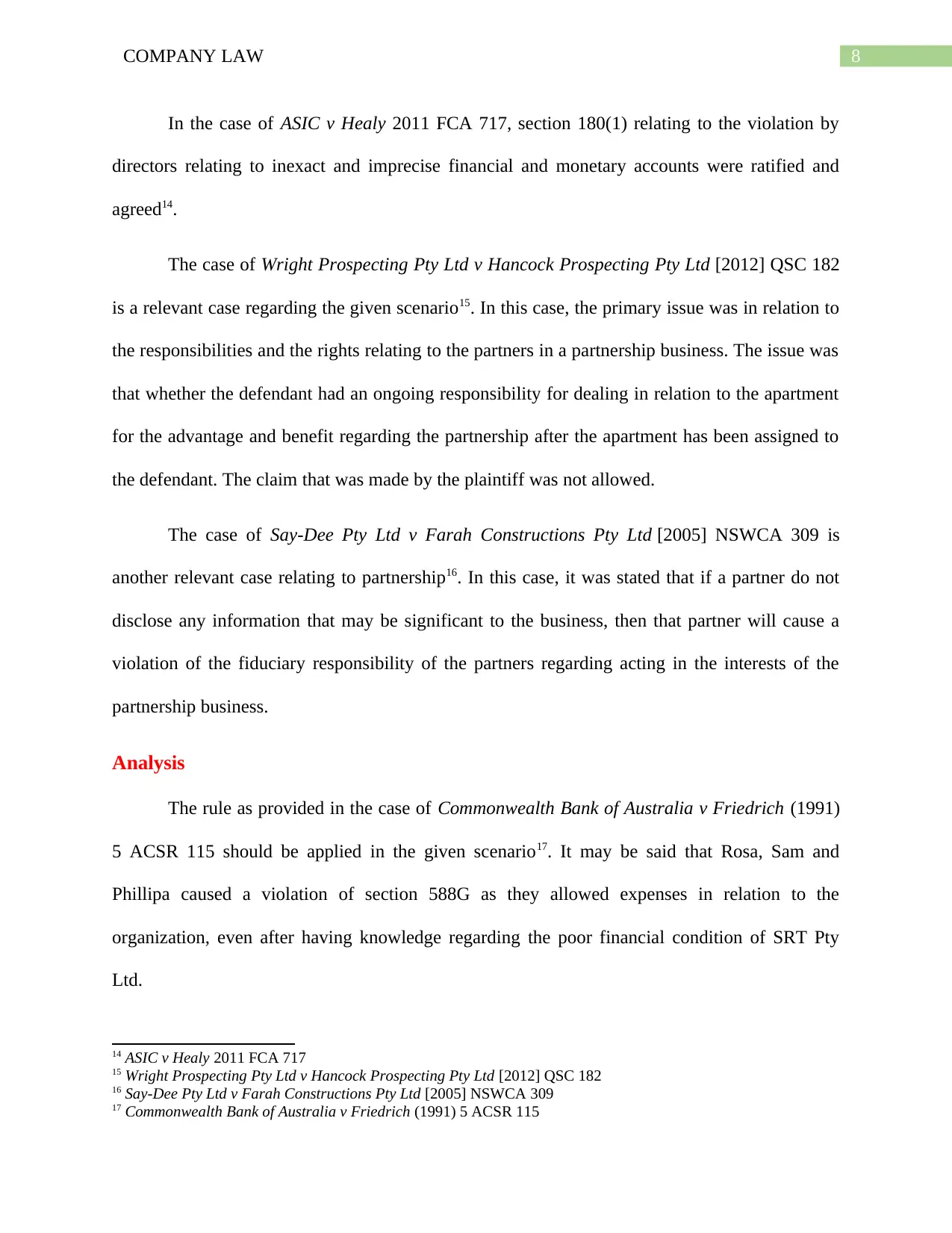
8COMPANY LAW
In the case of ASIC v Healy 2011 FCA 717, section 180(1) relating to the violation by
directors relating to inexact and imprecise financial and monetary accounts were ratified and
agreed14.
The case of Wright Prospecting Pty Ltd v Hancock Prospecting Pty Ltd [2012] QSC 182
is a relevant case regarding the given scenario15. In this case, the primary issue was in relation to
the responsibilities and the rights relating to the partners in a partnership business. The issue was
that whether the defendant had an ongoing responsibility for dealing in relation to the apartment
for the advantage and benefit regarding the partnership after the apartment has been assigned to
the defendant. The claim that was made by the plaintiff was not allowed.
The case of Say-Dee Pty Ltd v Farah Constructions Pty Ltd [2005] NSWCA 309 is
another relevant case relating to partnership16. In this case, it was stated that if a partner do not
disclose any information that may be significant to the business, then that partner will cause a
violation of the fiduciary responsibility of the partners regarding acting in the interests of the
partnership business.
Analysis
The rule as provided in the case of Commonwealth Bank of Australia v Friedrich (1991)
5 ACSR 115 should be applied in the given scenario17. It may be said that Rosa, Sam and
Phillipa caused a violation of section 588G as they allowed expenses in relation to the
organization, even after having knowledge regarding the poor financial condition of SRT Pty
Ltd.
14 ASIC v Healy 2011 FCA 717
15 Wright Prospecting Pty Ltd v Hancock Prospecting Pty Ltd [2012] QSC 182
16 Say-Dee Pty Ltd v Farah Constructions Pty Ltd [2005] NSWCA 309
17 Commonwealth Bank of Australia v Friedrich (1991) 5 ACSR 115
In the case of ASIC v Healy 2011 FCA 717, section 180(1) relating to the violation by
directors relating to inexact and imprecise financial and monetary accounts were ratified and
agreed14.
The case of Wright Prospecting Pty Ltd v Hancock Prospecting Pty Ltd [2012] QSC 182
is a relevant case regarding the given scenario15. In this case, the primary issue was in relation to
the responsibilities and the rights relating to the partners in a partnership business. The issue was
that whether the defendant had an ongoing responsibility for dealing in relation to the apartment
for the advantage and benefit regarding the partnership after the apartment has been assigned to
the defendant. The claim that was made by the plaintiff was not allowed.
The case of Say-Dee Pty Ltd v Farah Constructions Pty Ltd [2005] NSWCA 309 is
another relevant case relating to partnership16. In this case, it was stated that if a partner do not
disclose any information that may be significant to the business, then that partner will cause a
violation of the fiduciary responsibility of the partners regarding acting in the interests of the
partnership business.
Analysis
The rule as provided in the case of Commonwealth Bank of Australia v Friedrich (1991)
5 ACSR 115 should be applied in the given scenario17. It may be said that Rosa, Sam and
Phillipa caused a violation of section 588G as they allowed expenses in relation to the
organization, even after having knowledge regarding the poor financial condition of SRT Pty
Ltd.
14 ASIC v Healy 2011 FCA 717
15 Wright Prospecting Pty Ltd v Hancock Prospecting Pty Ltd [2012] QSC 182
16 Say-Dee Pty Ltd v Farah Constructions Pty Ltd [2005] NSWCA 309
17 Commonwealth Bank of Australia v Friedrich (1991) 5 ACSR 115
⊘ This is a preview!⊘
Do you want full access?
Subscribe today to unlock all pages.

Trusted by 1+ million students worldwide
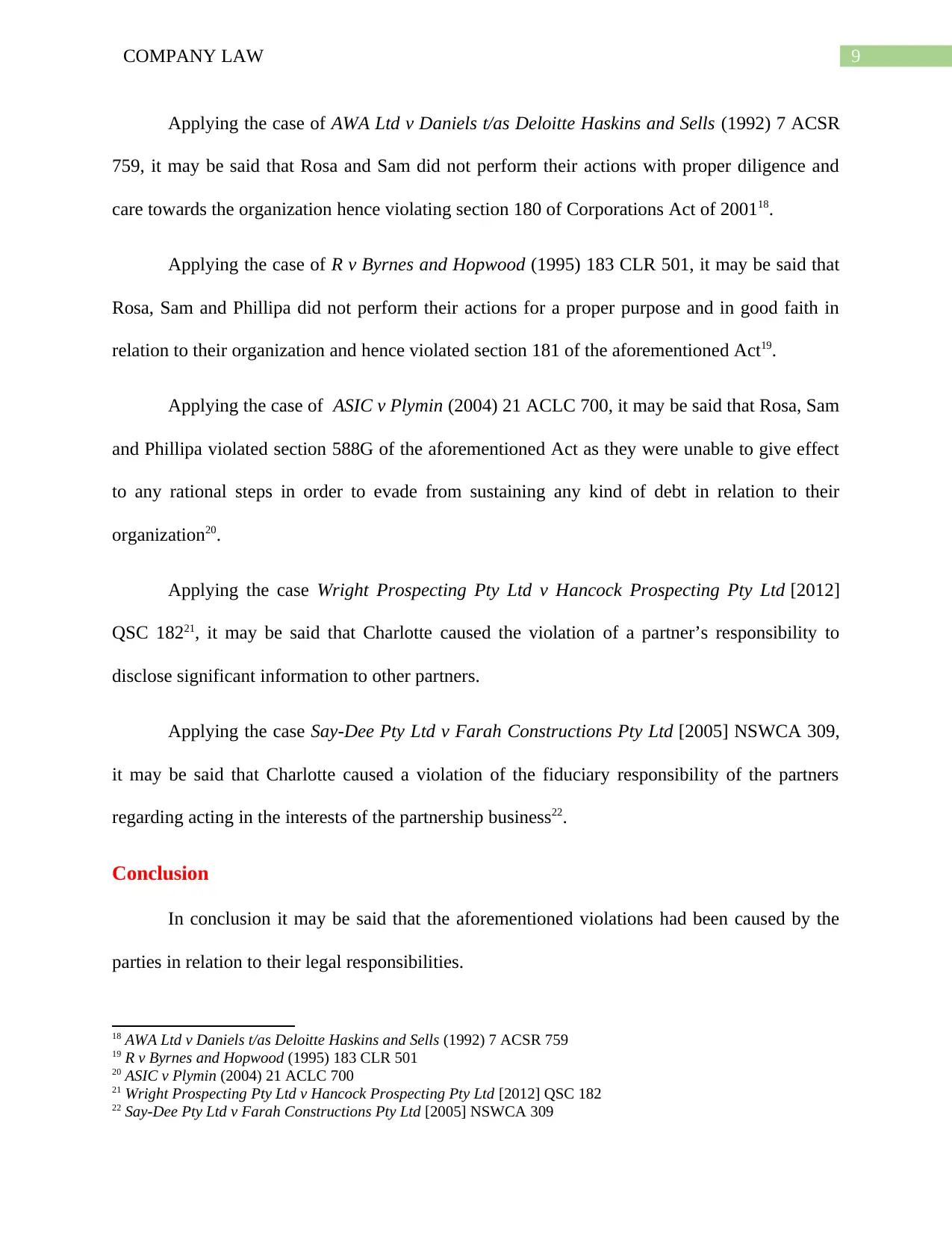
9COMPANY LAW
Applying the case of AWA Ltd v Daniels t/as Deloitte Haskins and Sells (1992) 7 ACSR
759, it may be said that Rosa and Sam did not perform their actions with proper diligence and
care towards the organization hence violating section 180 of Corporations Act of 200118.
Applying the case of R v Byrnes and Hopwood (1995) 183 CLR 501, it may be said that
Rosa, Sam and Phillipa did not perform their actions for a proper purpose and in good faith in
relation to their organization and hence violated section 181 of the aforementioned Act19.
Applying the case of ASIC v Plymin (2004) 21 ACLC 700, it may be said that Rosa, Sam
and Phillipa violated section 588G of the aforementioned Act as they were unable to give effect
to any rational steps in order to evade from sustaining any kind of debt in relation to their
organization20.
Applying the case Wright Prospecting Pty Ltd v Hancock Prospecting Pty Ltd [2012]
QSC 18221, it may be said that Charlotte caused the violation of a partner’s responsibility to
disclose significant information to other partners.
Applying the case Say-Dee Pty Ltd v Farah Constructions Pty Ltd [2005] NSWCA 309,
it may be said that Charlotte caused a violation of the fiduciary responsibility of the partners
regarding acting in the interests of the partnership business22.
Conclusion
In conclusion it may be said that the aforementioned violations had been caused by the
parties in relation to their legal responsibilities.
18 AWA Ltd v Daniels t/as Deloitte Haskins and Sells (1992) 7 ACSR 759
19 R v Byrnes and Hopwood (1995) 183 CLR 501
20 ASIC v Plymin (2004) 21 ACLC 700
21 Wright Prospecting Pty Ltd v Hancock Prospecting Pty Ltd [2012] QSC 182
22 Say-Dee Pty Ltd v Farah Constructions Pty Ltd [2005] NSWCA 309
Applying the case of AWA Ltd v Daniels t/as Deloitte Haskins and Sells (1992) 7 ACSR
759, it may be said that Rosa and Sam did not perform their actions with proper diligence and
care towards the organization hence violating section 180 of Corporations Act of 200118.
Applying the case of R v Byrnes and Hopwood (1995) 183 CLR 501, it may be said that
Rosa, Sam and Phillipa did not perform their actions for a proper purpose and in good faith in
relation to their organization and hence violated section 181 of the aforementioned Act19.
Applying the case of ASIC v Plymin (2004) 21 ACLC 700, it may be said that Rosa, Sam
and Phillipa violated section 588G of the aforementioned Act as they were unable to give effect
to any rational steps in order to evade from sustaining any kind of debt in relation to their
organization20.
Applying the case Wright Prospecting Pty Ltd v Hancock Prospecting Pty Ltd [2012]
QSC 18221, it may be said that Charlotte caused the violation of a partner’s responsibility to
disclose significant information to other partners.
Applying the case Say-Dee Pty Ltd v Farah Constructions Pty Ltd [2005] NSWCA 309,
it may be said that Charlotte caused a violation of the fiduciary responsibility of the partners
regarding acting in the interests of the partnership business22.
Conclusion
In conclusion it may be said that the aforementioned violations had been caused by the
parties in relation to their legal responsibilities.
18 AWA Ltd v Daniels t/as Deloitte Haskins and Sells (1992) 7 ACSR 759
19 R v Byrnes and Hopwood (1995) 183 CLR 501
20 ASIC v Plymin (2004) 21 ACLC 700
21 Wright Prospecting Pty Ltd v Hancock Prospecting Pty Ltd [2012] QSC 182
22 Say-Dee Pty Ltd v Farah Constructions Pty Ltd [2005] NSWCA 309
Paraphrase This Document
Need a fresh take? Get an instant paraphrase of this document with our AI Paraphraser
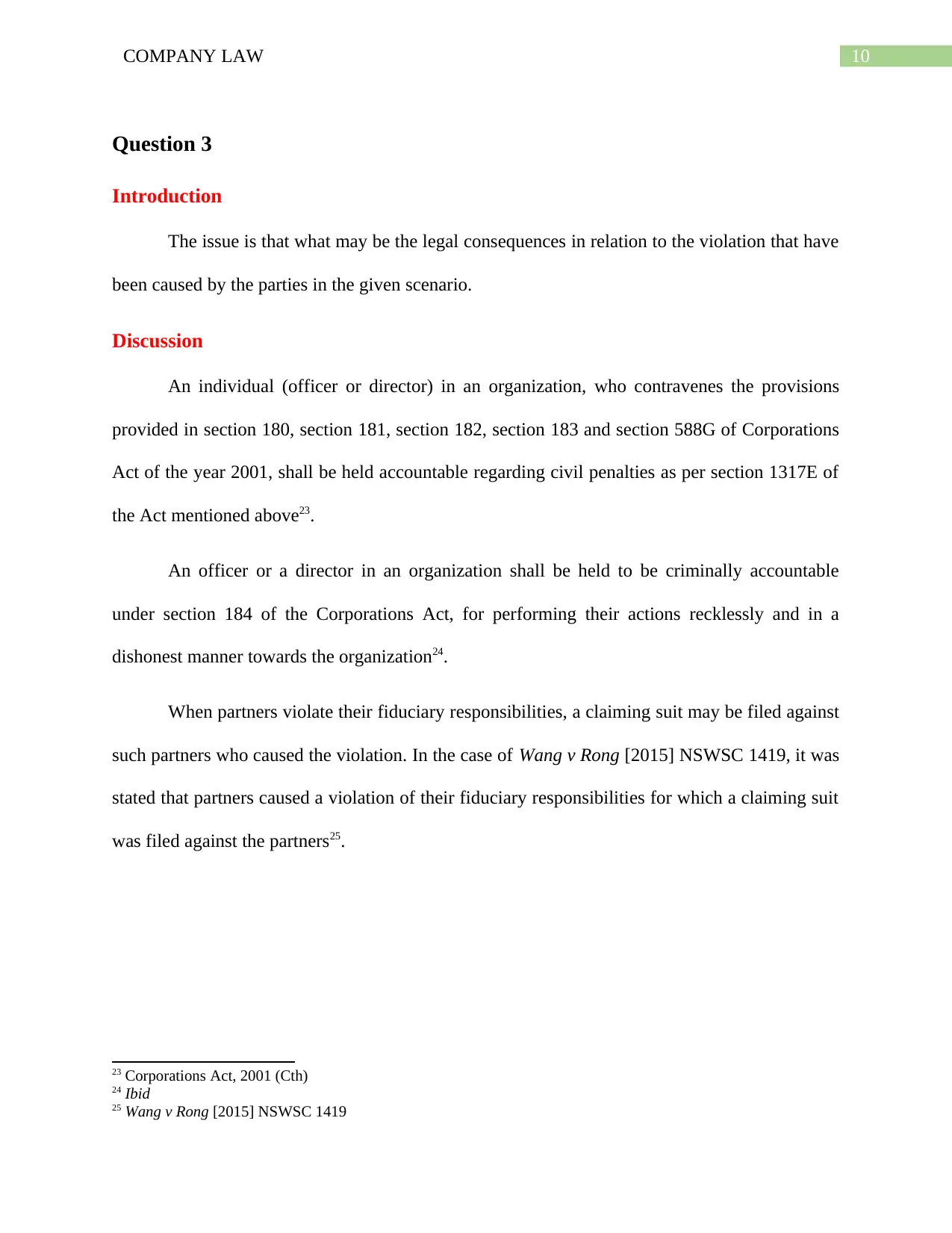
10COMPANY LAW
Question 3
Introduction
The issue is that what may be the legal consequences in relation to the violation that have
been caused by the parties in the given scenario.
Discussion
An individual (officer or director) in an organization, who contravenes the provisions
provided in section 180, section 181, section 182, section 183 and section 588G of Corporations
Act of the year 2001, shall be held accountable regarding civil penalties as per section 1317E of
the Act mentioned above23.
An officer or a director in an organization shall be held to be criminally accountable
under section 184 of the Corporations Act, for performing their actions recklessly and in a
dishonest manner towards the organization24.
When partners violate their fiduciary responsibilities, a claiming suit may be filed against
such partners who caused the violation. In the case of Wang v Rong [2015] NSWSC 1419, it was
stated that partners caused a violation of their fiduciary responsibilities for which a claiming suit
was filed against the partners25.
23 Corporations Act, 2001 (Cth)
24 Ibid
25 Wang v Rong [2015] NSWSC 1419
Question 3
Introduction
The issue is that what may be the legal consequences in relation to the violation that have
been caused by the parties in the given scenario.
Discussion
An individual (officer or director) in an organization, who contravenes the provisions
provided in section 180, section 181, section 182, section 183 and section 588G of Corporations
Act of the year 2001, shall be held accountable regarding civil penalties as per section 1317E of
the Act mentioned above23.
An officer or a director in an organization shall be held to be criminally accountable
under section 184 of the Corporations Act, for performing their actions recklessly and in a
dishonest manner towards the organization24.
When partners violate their fiduciary responsibilities, a claiming suit may be filed against
such partners who caused the violation. In the case of Wang v Rong [2015] NSWSC 1419, it was
stated that partners caused a violation of their fiduciary responsibilities for which a claiming suit
was filed against the partners25.
23 Corporations Act, 2001 (Cth)
24 Ibid
25 Wang v Rong [2015] NSWSC 1419
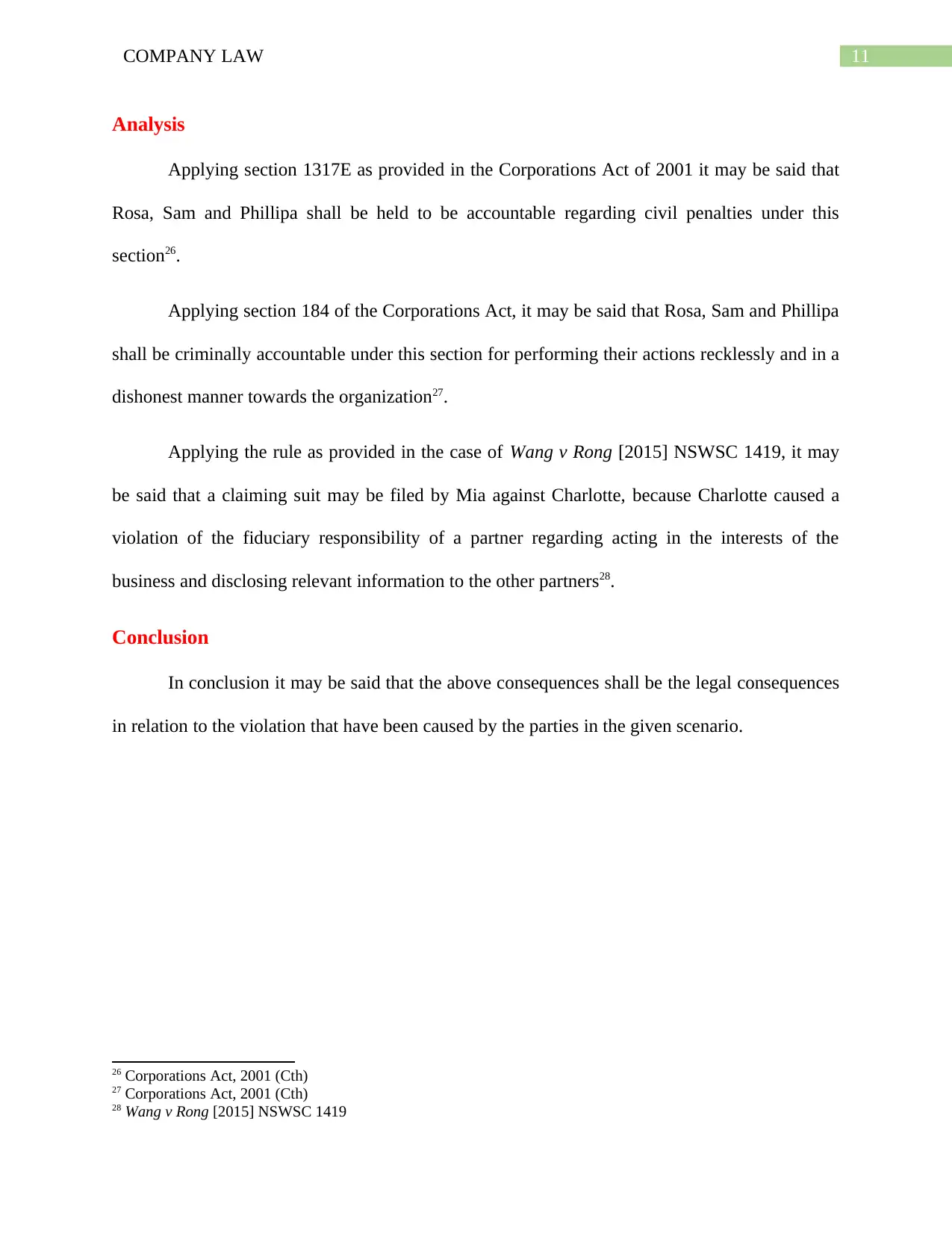
11COMPANY LAW
Analysis
Applying section 1317E as provided in the Corporations Act of 2001 it may be said that
Rosa, Sam and Phillipa shall be held to be accountable regarding civil penalties under this
section26.
Applying section 184 of the Corporations Act, it may be said that Rosa, Sam and Phillipa
shall be criminally accountable under this section for performing their actions recklessly and in a
dishonest manner towards the organization27.
Applying the rule as provided in the case of Wang v Rong [2015] NSWSC 1419, it may
be said that a claiming suit may be filed by Mia against Charlotte, because Charlotte caused a
violation of the fiduciary responsibility of a partner regarding acting in the interests of the
business and disclosing relevant information to the other partners28.
Conclusion
In conclusion it may be said that the above consequences shall be the legal consequences
in relation to the violation that have been caused by the parties in the given scenario.
26 Corporations Act, 2001 (Cth)
27 Corporations Act, 2001 (Cth)
28 Wang v Rong [2015] NSWSC 1419
Analysis
Applying section 1317E as provided in the Corporations Act of 2001 it may be said that
Rosa, Sam and Phillipa shall be held to be accountable regarding civil penalties under this
section26.
Applying section 184 of the Corporations Act, it may be said that Rosa, Sam and Phillipa
shall be criminally accountable under this section for performing their actions recklessly and in a
dishonest manner towards the organization27.
Applying the rule as provided in the case of Wang v Rong [2015] NSWSC 1419, it may
be said that a claiming suit may be filed by Mia against Charlotte, because Charlotte caused a
violation of the fiduciary responsibility of a partner regarding acting in the interests of the
business and disclosing relevant information to the other partners28.
Conclusion
In conclusion it may be said that the above consequences shall be the legal consequences
in relation to the violation that have been caused by the parties in the given scenario.
26 Corporations Act, 2001 (Cth)
27 Corporations Act, 2001 (Cth)
28 Wang v Rong [2015] NSWSC 1419
⊘ This is a preview!⊘
Do you want full access?
Subscribe today to unlock all pages.

Trusted by 1+ million students worldwide
1 out of 13
Related Documents
Your All-in-One AI-Powered Toolkit for Academic Success.
+13062052269
info@desklib.com
Available 24*7 on WhatsApp / Email
![[object Object]](/_next/static/media/star-bottom.7253800d.svg)
Unlock your academic potential
Copyright © 2020–2025 A2Z Services. All Rights Reserved. Developed and managed by ZUCOL.





